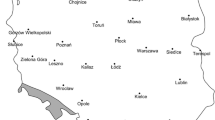Abstract
The territory of West Kazakhstan is an intensively developing region. The main oil and gas fields are concentrated there. In addition, this region is well-known as a region of nomad cattle breeding. Both of industry and agriculture demand a lot of employees, working in the open air in wintertime. Severe winter conditions, primary very low temperatures, and strong winds characterize the region. In this work, we calculated and analyzed the spatial and temporal distributions of effective temperatures in the region and their dynamics due to the global warming in the last decades. To calculate the equivalent temperature (WCET) was used the method of OFCM 2003. Nowadays, it is known as a common method for similar studies. It was shown that in the observed region, WCET is significantly lower than the ambient temperature. Repeatability of WCET, corresponding to «increasing risk», «high risk» is high in the main part of the region. Global warming in the region results in returning extremely high temperatures of the air, decreasing repeatability of the average gradation of WCET approximately on 4%, but there is no any visible changing repeatability of extreme WCET. Obtained results can be used for planning any construction work in the open air and agriculture branches.



Similar content being viewed by others
References
Amelung B, Moreno A (2009) Impacts of climate change in tourism in Europe. PESETA—Tourism study—Publication—IPTS Web Site
Baranovska M, Garbil B (1998) Biometeorological norms as tolerance interval of man to weather stimuli. Int J Biometeorol 25:123–126
Beku B, Nyssanbayeva AS (2013) Ocenka bioklimaticheskih uslovij juga i jugo-vostoka Kazahstana. Gidrometeorologija i jekologija 1:53–65
Bluestain M, Zecher J (1999) A new approach to an accurate wind chill factor. Bull Am Meteorol Soc 80:1893–1899
Bugaev VA et al. (1997) Sinopticheskie processy Srednej Azii / Tashkent. 477 p
Cherednichenko AV (2010) Izmenenie klimata Kazahstana i vozmozhnosti po adaptacii za schjot dostupnyh vlagozapasov oblachnosti. Bishkek, izd. ILIM, 2010. -260s
Cherednichenko AV (2015) Dinamika klimata Kazahstana. Nachalo jepohi poholodanija. Almaty, 2015, 237s
Cherednichenko A, Cherednichenko A, Cherednichenko VS, Vilesov EN (2015) Climate change in the City of Almaty during the past 120 years. Quat Int J. homepage: www.elsevier.com/locate/quaint
Climate change (2007) The Physical science basis. In: Solomon S, Qin D, Manning M, et al. (eds) Cambridge: New York: Cambridge University Press, 996 p
CWCP (2015) Canada’s wind chill program. http://www.ec.gc.ca/meteo-weather/deaoult.asp?lang=En&n=5FBF816A–1 [22.02.2015]
Dixon DC, Prior MJ (1987) Wind – chill indices review. Meteorol Mag 116:1–16
Enciklopedija klimaticheskih resursov Rossijskoj federacii (2005) / pod red. Kobyshevoj N.V, Hajrullina K.Sh../ SPb.: Gidrometeoizdat: 319 p
Epstein Y, Moran DS (2006) Thermal comfort and the heat stress indices. Ind Health 44(88):398
Grillakis MG, Koultrouris AG, Tsanis IK (2016) The 2 C global warming effect on summer European tourism through different indices. Int J Diometeorol 60:1206–1215
Gruza GV, Ran’kova J (1989) Shema verojatnostnogo adaptivnogo meteorologicheskogo prognoza (gruppovye analogi) s optimizaciej sostava prediktorov / Trudy GMC SSSR, Vyp. 306. – S. 38–55
Gruza GV, Ran’kova J (1991) Verojatnostnyj prognoz prizemnoj global'noj temperatury do 2005 goda. Meteorologija i gidrologija, № 4. – S:95–103
Gruza GV, Ran’kova J (2004) Obnaruzhenie izmenenij klimata: sostojanie, izmenchivost' i jekstremal'nost' klimata. Meteorologija i gidrologija 4:50–68
Gu O, Philander GH (1995) Secular changes of annual and interannual variability in the tropics during the past century. J Clim 8(4):864–876
IPCC (2013) Summary for policymakers. In Stocker TF et al (eds.) Climate change 2013: the physical science bases. Contribution of Working Group 1 to the Fifth Assessment Report of the Intergovernmental Panel on climate change. Cambridge University Press, Cambridge, UK and New York, USA (http://www.ipcc.ch)
Kalkstein LS, Valimount KM (1986) An evaluation of summer discomfort in the United States using a relative climatological index. Bull Am Meteorol Soc 7:842–848
OFCM (2003) Report on wind chill temperature and extreme heat indices: evaluation and improvement projects. http://www.0fcm.gov/jagti/r19-ti-plan/pdf/entire_ti.pdf. [04.11.2015]
Oscizevski R, Bluestain M (2005) The new wind chill equivalent temperature chart. Bull Am Meteorol Soc 86:1453–1458
Perevedentsev JuP (2009) Teorija klimata. Izd. Kazanskogo gosudarstvenogo Universiteta. - 486 s
Perevedentsev JuP, Ismagilov NV, Naumov EP, Shantalinski KM, Gogol FV, Isaeva MV (2009) Harakteristika bioklimata respubliki Tatarstan/Uchjonye zapiski Kazanskogo universiteta, T 151, kn. 3:239–246
Saue T (2016) Directrional distribution of chilling winds in Estonia. Int Biometeorol 60:1165–1173
Shabat BY, Sitzer A, Dusan F (2014) Modified wind chill temperatures determined by a whole body thermoregulation model and human based facial convective coefficients. Int J Biometeorol 58:1007–1015
Shitzer A, de Dear R (2006) Inconsistencies in the “new” wind chill chart at low wind speeds. J Appl Meteorol Climatol 45:787–790
Shitzer A, Tukuises P (2012) Advances, shortcomings, and recommendations for wind chill estimation. Int J Biometeorol 56:495–503
Siple PA, Passel SF (1945) Measurements of dry atmospheric cooling in subfreezing temperatures. Proc Am Philos Soc 89:177–199
Soomere T, Keevallik (2003) Anizotropi of moderate and strong winds in the Baltic proper. Proceedings of the Estonian Academy of Sciences, Engeneering 9:73–90
Spravochnik po klimatu Kazahstana (2005) vyp. I -HIV, Almaty
Van laer E, Moons CPH, Sonk B, Tuyttens FAM (2014) Importance of outdoor shelter for cattle in temperate climates. Livest Sci 159:87–101
WHO/WMO/UNEP (1996) Climate and health: the potential impacts of climate change. WHO/WMO/UNEP, Geneva
Zheng Y, Shao X, Lu F, Li V (2016) February – May temperature reconstraction based on tree-ring widths of Abies furgesii from the Shennongjia area in central China. Int J Biometeorol 60:1175–1181
Author information
Authors and Affiliations
Corresponding author
Rights and permissions
About this article
Cite this article
Nyssanbayeva, A.S., Cherednichenko, A.V., Cherednichenko, V.S. et al. Bioclimatic conditions of the winter months in Western Kazakhstan and their dynamics in relation to climate change. Int J Biometeorol 63, 659–669 (2019). https://doi.org/10.1007/s00484-018-1513-7
Received:
Revised:
Accepted:
Published:
Issue Date:
DOI: https://doi.org/10.1007/s00484-018-1513-7




